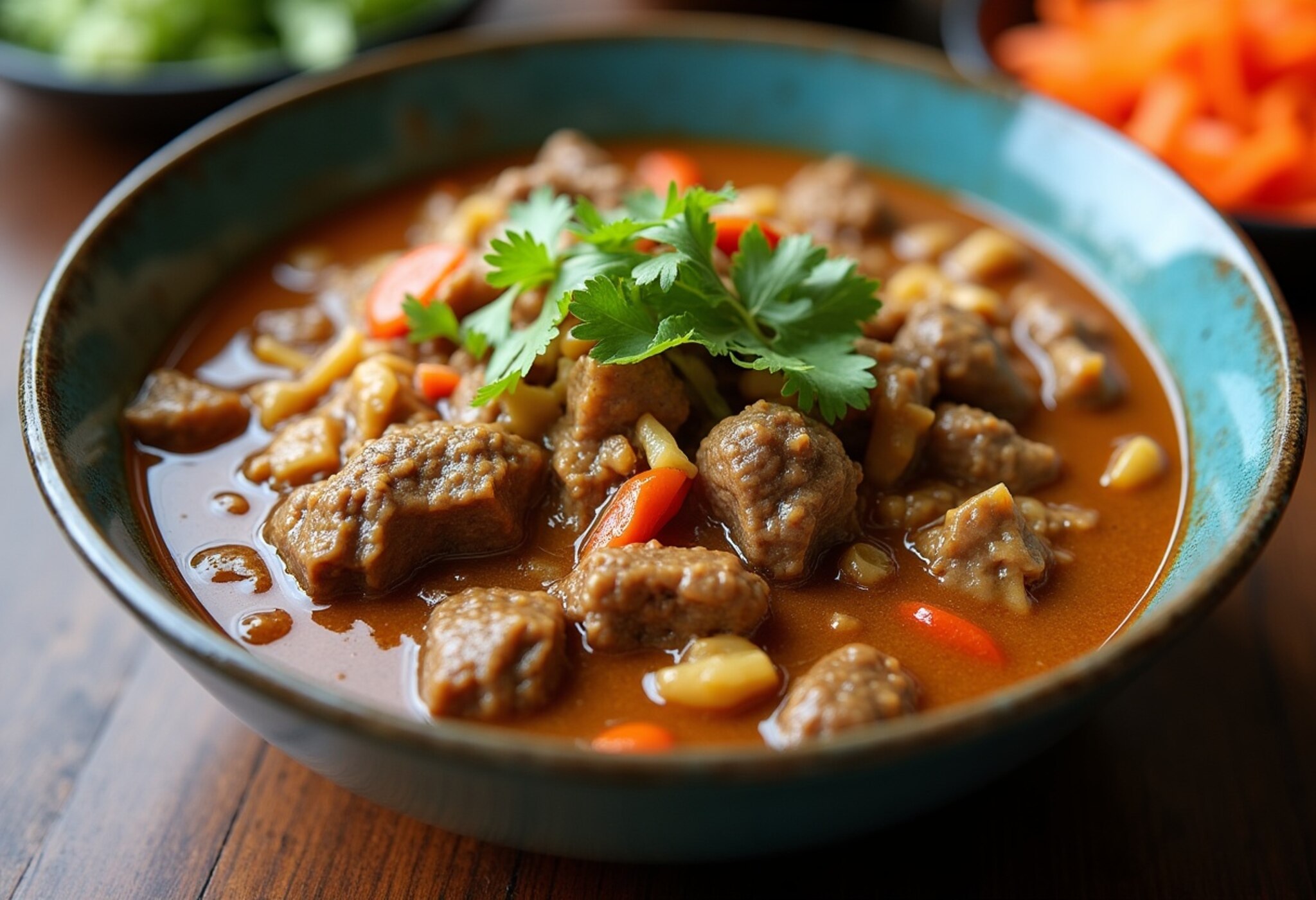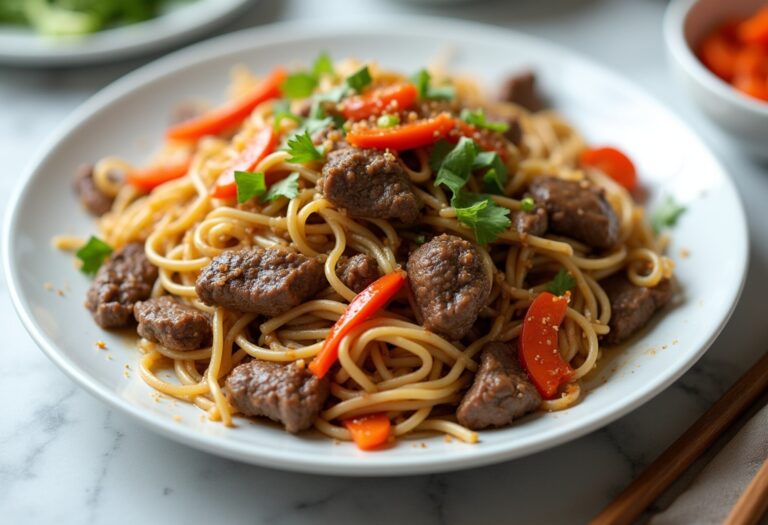Beef Kare Kare Recipe

Beef kare kare is a beloved Filipino dish that has captured the hearts (and stomachs) of food enthusiasts around the world. This rich and flavorful stew is a testament to the vibrant culinary heritage of the Philippines, blending savory, nutty, and slightly sweet flavors into a harmonious and comforting dish.
Originating from the Tagalog region, kare kare has become a staple in Filipino households, often reserved for special occasions or as a Sunday family feast. The dish’s allure lies in its unique peanut-based sauce, which lends a velvety texture and a depth of flavor that complements the tender beef perfectly.
❤️ Why You’ll Love This Recipe ❓
What sets this beef kare kare recipe apart is the perfect balance of flavors and textures. The tender beef, which practically melts in your mouth, is complemented by the rich, nutty sauce that coats each bite. The addition of crunchy vegetables, such as eggplant and string beans, provides a delightful contrast, making every forkful a delightful experience.
One of the best things about this recipe is its accessibility. Many of the ingredients are pantry or freezer staples, making it easy to whip up on a whim. Plus, the dish can be prepared in advance, allowing you to savor the flavors even more as the ingredients meld together. Whether you’re serving it as a comforting weeknight meal or a show-stopping centerpiece for a special occasion, this beef kare kare is sure to impress.
🛒 What You Need to Prepare Beef Kare Kare ❓
• 1 large onion, diced
• 3 cloves garlic, minced
• 1 cup unsweetened peanut butter
• 4 cups beef broth
• 2 tablespoons fish sauce
• 1 tablespoon brown sugar
• 1 teaspoon ground turmeric
• 1 teaspoon ground coriander
• 1 teaspoon ground cumin
• 1 eggplant, cut into 1-inch cubes
• 1 pound string beans, cut into 2-inch pieces
• Salt and pepper to taste
• Cooked rice, for serving
The beauty of this beef kare kare recipe is that most ingredients are pantry or freezer staples. The combination of tender beef, rich peanut butter, and aromatic spices creates the Filipino-inspired flavor profile that has made kare kare recipes perennially popular.
📝 How to Make Beef Kare Kare Step-by-Step ❓
• Step 2: In the same pot, sauté the onions and garlic until fragrant and translucent, about 3-4 minutes.
• Step 3: Add the peanut butter, beef broth, fish sauce, brown sugar, turmeric, coriander, and cumin. Whisk to combine and bring the mixture to a simmer.
• Step 4: Return the browned beef to the pot and reduce the heat to low. Simmer, covered, for 1 hour, or until the beef is very tender.
• Step 5: Add the eggplant and string beans to the pot. Continue simmering, uncovered, for an additional 15-20 minutes, or until the vegetables are tender.
• Step 6: Season with salt and pepper to taste.
⏱️ Timing Overview
• Cooking time: 1 hour 15 minutes
• Total time: 1 hour 35 minutes
Compared to traditional Filipino kare kare dishes, which can take up to 2 hours to prepare, this beef kare kare recipe saves you 25% of your cooking time while delivering similar flavors.
👩🏻⚕️ Nutritional Information
Per serving (based on 6 servings):
• Protein: 36g
• Carbohydrates: 22g
• Fat: 30g
• Fiber: 7g
• Sodium: 695mg
These beef kare kare provide approximately 72% of your daily protein requirements and 28% of your daily fiber needs, making them not just delicious but nutritionally valuable as well.
🔄 Healthier Alternatives for the Recipe
• Lower-carb version: Substitute the rice with cauliflower rice or shirataki noodles.
• Dairy-free adaptation: Replace the butter with coconut oil or olive oil, and use a dairy-free peanut butter.
• Added protein: Serve the kare kare with grilled or sautéed shrimp or chicken for an extra protein boost.
• Boost vegetables: Add more vegetables, such as broccoli, bell peppers, or mushrooms, to increase the nutrient content.
These modifications can reduce calories by up to 20% or adapt the recipe for specific dietary needs without compromising the fundamental flavor profile of the beef kare kare.
🍽️ Serving Suggestions
• Pair the kare kare with a refreshing tomato and onion salad for a balanced meal.
• Complement the dish with a Filipino-inspired soup, such as sinigang or lentil soup, for a complete feast.
• For a family-style gathering, serve the beef kare kare alongside other Filipino dishes like lumpia (spring rolls) or adobo chicken.
• Create a festive platter with the kare kare, accompanied by fresh herbs, chili peppers, and lime wedges for added flavor and presentation.
❌ Common Mistakes to Avoid
• Undercooked vegetables: The eggplant and string beans should be tender but still have a slight bite. Overcooking can make them mushy and unappealing.
• Imbalanced seasoning: It’s important to taste and adjust the seasoning as needed, ensuring the perfect balance of salty, sweet, and nutty flavors.
• Skipping the browning step: Browning the beef is crucial for developing rich, caramelized flavors that enhance the overall dish.
• Not letting the flavors meld: Allowing the kare kare to simmer for the recommended time ensures the ingredients have a chance to fully integrate and develop the signature taste.
🧊 Storing Tips for the Recipe
These beef kare kare retain their quality remarkably well:
• Freezing unbaked: Prepare the kare kare up to the point of adding the vegetables, then transfer to a freezer-safe container and freeze for up to 3 months. Thaw in the refrigerator overnight before reheating and adding the vegetables.
• Freezing baked: Allow the cooked kare kare to cool completely, then transfer to a freezer-safe container and freeze for up to 3 months. Thaw in the refrigerator overnight and reheat gently on the stovetop or in the oven until heated through.
• Reheating: Gently reheat the kare kare on the stovetop over medium-low heat, stirring occasionally, until warmed through. You can also reheat it in the oven at 350°F (175°C) for 15-20 minutes, or until heated to your desired temperature.
❓ FAQs
Can I make the beef kare kare in advance?
Absolutely! This dish actually benefits from being made a day or two in advance. The flavors will have more time to meld, and the beef will become even more tender. Simply store the cooled kare kare in an airtight container in the refrigerator for up to 4 days. When ready to serve, gently reheat on the stovetop or in the oven until heated through.
Can I substitute the beef with another protein?
Yes, you can use different proteins in this recipe. Pork, chicken, or even seafood (such as shrimp or squid) can all work well. Just be mindful of adjusting the cooking times accordingly. For example, chicken or shrimp may require less simmering time compared to beef or pork.
Is there a gluten-free or dairy-free version of this recipe?
Absolutely! To make this beef kare kare gluten-free, simply use a gluten-free fish sauce and serve it with gluten-free rice or cauliflower rice. For a dairy-free version, replace the butter with coconut oil or olive oil, and use a dairy-free peanut butter. These modifications make the dish suitable for those with dietary restrictions without compromising the flavor.
Why is my kare kare sauce too thick or too thin?
If your kare kare sauce is too thick, you can thin it out by adding more beef broth, one ladle at a time, until you reach the desired consistency. Conversely, if the sauce is too thin, you can make a slurry with a tablespoon of cornstarch and a few tablespoons of the hot sauce, then whisk it back into the pot to thicken the mixture.
Can I add more vegetables to this recipe?
Absolutely! The beauty of this kare kare recipe is its versatility. You can easily add more vegetables, such as bell peppers, carrots, or even potatoes, to increase the nutrient content and create a more substantial dish. Just be sure to adjust the cooking time accordingly, as different vegetables may require varying simmering times.
Conclusion
These beef kare kare represent the perfect balance of convenience, flavor, and presentation. Whether you’re serving them as a comforting weeknight meal or a centerpiece for a special occasion, they’re sure to impress with their rich, nutty flavors and tender texture. The versatility of this recipe allows for countless variations to suit your taste preferences and dietary needs.
With simple ingredients and straightforward preparation, these beef kare kare demonstrate that sophisticated flavors don’t require complicated techniques – just quality ingredients and a little bit of care in the cooking process. So why not give this authentic Filipino dish a try and experience the true taste of the Philippines in your own home?
Print
Beef Kare Kare Recipe
- Total Time: 1 hour 35 minutes
Ingredients
• 2 pounds beef chuck, cut into 1-inch cubes
• 1 large onion, diced
• 3 cloves garlic, minced
• 1 cup unsweetened peanut butter
• 4 cups beef broth
• 2 tablespoons fish sauce
• 1 tablespoon brown sugar
• 1 teaspoon ground turmeric
• 1 teaspoon ground coriander
• 1 teaspoon ground cumin
• 1 eggplant, cut into 1-inch cubes
• 1 pound string beans, cut into 2-inch pieces
• Salt and pepper to taste
• Cooked rice, for serving
Instructions
• Step 1: In a large pot or Dutch oven, brown the beef cubes over medium-high heat until deeply caramelized, about 5-7 minutes. Remove the beef from the pot and set aside.
• Step 2: In the same pot, sauté the onions and garlic until fragrant and translucent, about 3-4 minutes.
• Step 3: Add the peanut butter, beef broth, fish sauce, brown sugar, turmeric, coriander, and cumin. Whisk to combine and bring the mixture to a simmer.
• Step 4: Return the browned beef to the pot and reduce the heat to low. Simmer, covered, for 1 hour, or until the beef is very tender.
• Step 5: Add the eggplant and string beans to the pot. Continue simmering, uncovered, for an additional 15-20 minutes, or until the vegetables are tender.
• Step 6: Season with salt and pepper to taste.
- Prep Time: 20 minutes
- Cook Time: 1 hour 15 minutes
- Category: Dinner
- Cuisine: Americans
Keywords: Beef Kare Kare Recipe






